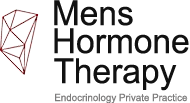Growth Hormone secretion and function
Growth hormone (GH) is a substance made by a gland located at the base of the brain called pituitary gland or master gland. The pituitary gland in turn is controlled by another brain structure, the hypothalamus and has different cells in it that produce different types of hormones.
GH is the most abundant pituitary hormone and is produced in a pulsating manner under the influence of at least two hypothalamic peptides. The hypothalamic growth hormone-releasing hormone, which stimulates GH secretion and somatostatin, which inhibits GH secretion. Recently, another peptide which is surprisingly secreted by the stomach and is called ghrelin, appears to stimulate GH secretion too.
GH has direct effects but many of its actions are mediated through insulin-like growth factor –I (IGF-I), which is another hormone like substance with a structure similar to insulin. Circulating IGF-I is almost exclusively derived from the liver in response to pituitary GH and also in response to exogenous administered growth hormone. Hence can be used to monitor and evaluate the response to growth hormone therapy.
Interestingly it is not only the circulating IGF-I from the liver but also the locally produced IGF-I in almost every tissue, which plays an essential role in GH action. Therefore, GH exerts its effect in at least three different ways. Firstly, acting on its own in different tissues, secondly by the liver circulating IGF-I and finally, by the locally produced IGF-I in most of tissues under the influence of GH.
The primary function of GH as its name implies, is to help children during childhood and adolescence getting taller. In adults, GH stimulates protein synthesis and consequently increases muscle and bone mass and improves muscle strength. On the other hand, assists the lipids break down, therefore could decrease belly and body fat.
Growth hormone plays a very important role in metabolism, too. This is the process by which cells change food into energy and make other substances that the body needs.
Severe GH deficiency in children is presented with very short stature and failure to grow. In adults growth hormone deficiency results in detrimental changes in body composition such as increase in body fat and decrease in muscle mass and strength. Furthermore, reduced stamina, physical function and quality of life, sense of well-being and high cholesterol levels are all well known symptoms and signs of GH deficiency.
Growth Hormone secretion and aging
Total daily GH secretion and IGF-I production declines progressively during adult life. Consequently, more than 30% of older men have IGF-I levels lower than the young adult reference range. Growth hormone is secreted almost exclusively through the 10 to 20 daily recorded secretory bursts with the highest pulses occurring during the sleep period, so that more than 70% of daily GH is secreted during night.
Aging is associated with a significant alteration of GH secretion patterns so that most of GH is secreted during the day instead and is associated with a steep decline of total daily secretion. Accordingly, it has been demonstrated that for each decade of increasing age daily GH secretion reduces by 14% and in a 70 year old man GH secretion has declined by more than 70%.
Reduced stimulatory activity of the hypothalamic GH releasing hormone, changes in body fat and testosterone levels with aging, were all implicated in reduced GH secretion with age.
Growth hormone replacement therapy
Growth hormone replacement therapy in growth hormone deficient men increases their body muscle mass while at the same time decreases body fat with the greater reduction observed in belly fat.
Furthermore, growth hormone replacement therapy increases the bone mass and has a beneficial effect on the lipid profile by lowering the bad cholesterol levels. Improvement in physical performance may require longer periods of treatment when growth hormone is given as a sole agent.
When however, we combine growth hormone with testosterone in suitable individuals, it appears that it preferentially affects skeletal muscle mass and indeed, physical performance and exercise capacity change for the better.
